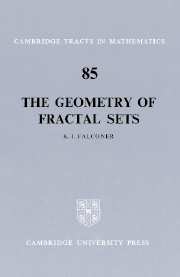Book contents
- Frontmatter
- Contents
- Preface
- Introduction
- Notation
- 1 Measure and dimension
- 2 Basic density properties
- 3 Structure of sets of integral dimension
- 4 Structure of sets of non-integral dimension
- 5 Comparable net measures
- 6 Projection properties
- 7 Besicovitch and Kakeya sets
- 8 Miscellaneous examples of fractal sets
- References
- Index
3 - Structure of sets of integral dimension
Published online by Cambridge University Press: 25 January 2010
- Frontmatter
- Contents
- Preface
- Introduction
- Notation
- 1 Measure and dimension
- 2 Basic density properties
- 3 Structure of sets of integral dimension
- 4 Structure of sets of non-integral dimension
- 5 Comparable net measures
- 6 Projection properties
- 7 Besicovitch and Kakeya sets
- 8 Miscellaneous examples of fractal sets
- References
- Index
Summary
Introduction
In this chapter we discuss the density and tangency structure of s-sets in ℝn when s is an integer. We know from Corollary 2.10 that an s-set splits into a regular part and an irregular part, and we find that these two types of set exhibit markedly different properties. One of our aims is to characterize regular sets as subsets of countable unions of rectifiable curves or surfaces, and thus to relate the measure theoretic and the descriptive topological ideas.
We present in detail the theory of linearly measurable sets or 1-sets in ℝ2. This work is almost entirely due to Besicovitch (1928a, 1938), the latter paper including some improved proofs as well as further results. Most of his proofs seem hard to better except in relatively minor ways and, hopefully, in presentation. Certainly, some of the geometrical methods used by Besicovitch involve such a degree of ingenuity that it is surprising that they were ever thought of at all. Some of the work in this chapter is also described in de Guzman (1981).
Curves and continua
Regular 1-sets and rectifiable curves are intimately related. Indeed, a regular 1-set is, to within a set of measure zero, a subset of a countable collection of rectifiable curves. This section is devoted to a study of curves, mainly from a topological viewpoint and in relation to continua of finite linear measure. Here we work in ℝn as the theory is no more complicated than for plane curves.
A curve (or Jordan curve) Γ is the image of a continuous injection ψ:[a,b]→ℝn, where [a,b]⊂:ℝ is a closed interval. Any curve is a continuum, that is, a compact connected set.
- Type
- Chapter
- Information
- The Geometry of Fractal Sets , pp. 28 - 53Publisher: Cambridge University PressPrint publication year: 1985



